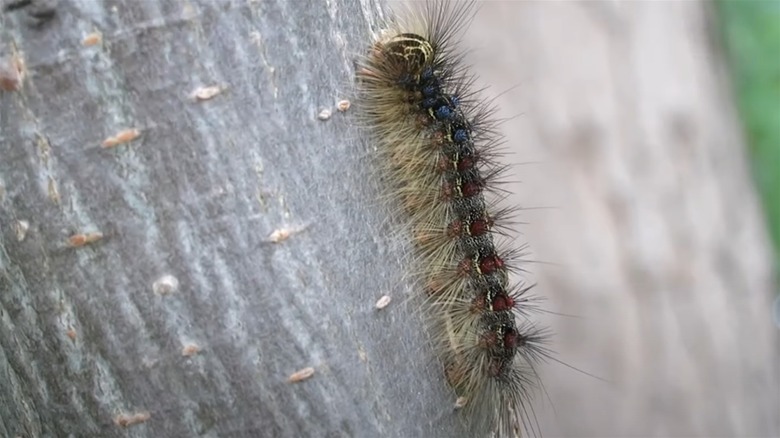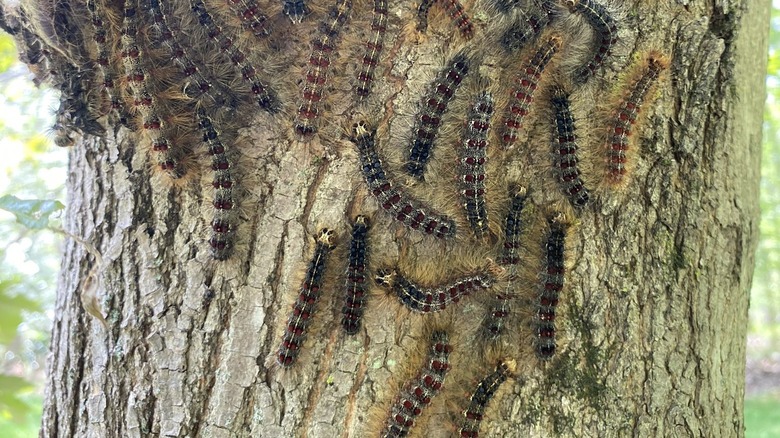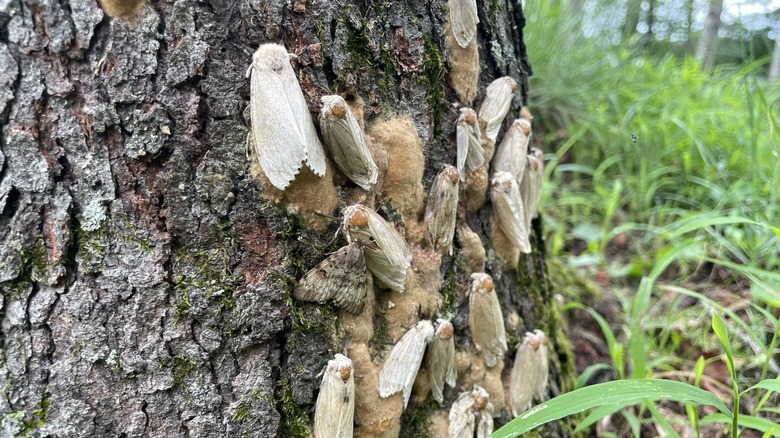You Should Keep An Eye Out For This Tree-Killing Pest In Your Yard
Invasive species can cause havoc in your yard whether they are plants like creeping bellflower or tree of heaven or insects like Japanese beetles or the spotted lanternfly. While Japanese beetles and spotted lanternflies have gotten plenty of attention in the news, one invasive insect that can damage your yard and even kill your trees that isn't talked about as much is the spongy moth. Spongy moths (previously known as gypsy moths) came to the United States from Europe in 1869 and have spread all over the Northeastern U.S. and into some midwestern states like Wisconsin, Michigan, Illinois, Indiana, and Ohio.
The issue with spongy moths is that they can be hard to identify because they look similar to many other native species that are harmless. As caterpillars, spongy moths are fuzzy with brown and black stripes, making them appear similar to harmless natives like wooly bear caterpillars or the eastern tent caterpillars. However, you can easily tell a spongy moth caterpillar from the others by looking at its spots. Spongy moth caterpillars have five sets of blue spots followed by six pairs of red spots down their backs. During the adult stage, male and female spongy moths look different. Male spongy moths have brown wings with black wavy lines and are slightly smaller while the females are white with brown wavy lines and don't fly.
Why spongy moths are harmful pests
Although they look quite innocent (almost like a common moth), spongy moths are hiding a dirty secret — they can cause a lot of damage to trees, especially while in the caterpillar stage. Spongy moth caterpillars have a large appetite and are willing to eat the leaves of more than 300 species of trees in North America. According to the USDA, when these hungry caterpillars get on a tree they are capable of eating almost all of the leaves, weakening the tree to the point of possibly killing it.
Unfortunately, while they like the leaves of various tree species, these caterpillars especially prefer oak trees and have been responsible for the destruction of oak forests around North America. If oak trees are unavailable, these critters are also happy to feast on many other hardwoods like beech, birch, elm, and maple. They also aren't opposed to pines, spruces, and willows. While one year of a tree having its leaves eaten by spongy moth caterpillars will likely not kill it (if it is a healthy tree), multiple years of spongy moth caterpillar presence combined with other factors such as drought will kill a tree.
What to do if you have spongy moths on your trees
If you see spongy moth caterpillars or egg masses on your trees, the first step you can take is to look up your local state environmental agency and report the problem so they can keep track of the spread. Then, if you believe the caterpillars will be a threat to your trees, you can start treating the problem.
In the early spring and late fall, search your yard for egg masses which can be present on trees, woodpiles, walls, and even lawn furniture and look like brownish-yellow fuzzy clumps. Egg clusters will survive the winter and must be destroyed by being scrapped off of trees or walls and plunged into boiling water.
In late spring, you will start seeing caterpillars which can be killed using a special spongy moth trap or by spraying the foliage of trees with an insecticide that is specifically effective on spongy moths. You can also prevent the caterpillars from climbing your trees by making a sticky barrier. These are commonly created by placing a ring of duct tape around the trunk of a tree and then coating the tape in a sticky substance like Tanglefoot. When you start seeing the adult spongy moths in late summer, the best thing to do is crush the insects and brush them off the tree.


